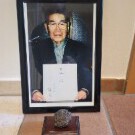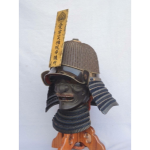
Peter Bleed
Gold Tier-
Posts
1,863 -
Joined
-
Last visited
-
Days Won
8
Peter Bleed last won the day on March 27 2023
Peter Bleed had the most liked content!
About Peter Bleed

- Birthday 11/03/1943
Profile Information
-
Gender
Male
-
Location:
Little Rock, AR
-
Interests
Sendai Kunikane, Ainu blades and artifacts, Namban fittings, rapiers
Profile Fields
-
Name
Peter Bleed
Recent Profile Visitors
3,608 profile views
Peter Bleed's Achievements
-
Dale, Out of pure boredom, I have been doing some searching on what might could be considered 19th century Asian trade guns. This little gun sure strikes me as a potential candidate for that category. Japan was certainly involve in the northern trade. And they had lots of "surplus" arms. When you get this piece in had and can tell us about it, I sure hope that you will tell us what you can about it. Peter
-
Sho stamped gunto for 10K
Peter Bleed replied to John C's topic in Auctions and Online Sales or Sellers
Bruce, I think you are right, I'd make it Goto Kanehira Peter PS.And if I had one I'd let it go for 10 grand! -
I Give Up! 1942 - then what?
Peter Bleed replied to Bruce Pennington's topic in Translation Assistance
maybe I missed an earlier piece of this discussion, but this sword is dated to th2601 years since the Imperial founding - that took place in 2600BC - so this blades, therefore dates to 1942 AD. Ver patriotic! Peter -
Actually, I find this a rather interesting gun. I have to wonder why it was so modified and by whom. Was it a "Japanese" hunting gun, Ainu, mebbe, and I would rule out the possibility that it cam from elsewhere, Korean or Manchuria? I agree, too, that it is basically and best currently a "Parts kit." I am interested ... Peter
-
This was a wonderful example of how this list can/might work. I know of no one who would "want" this sword, BUT the down side pot6ential is limited and the learning potential is great. With work, interaction, and care, this will become a presentable "samurai sword." in in doing that you will have 1) learned, 2) communicated, 3)practiced (you likely will "try" some polishing, be careful, go slowly and read). Get the tsuka wrapped and a katana-kake and you have done no serious damage, but gained a display piece. Peter
-
What happens to collectons?
Peter Bleed replied to Peter Bleed's topic in General Nihonto Related Discussion
I hope this discussion is still worthwhile and substantive. I am SURE that the bulk of "the collections" currently in the State are residues of WWII era bring-back albeit with lots of post-War research, repair, and assessment. We will soon see the end of that era, but it is WHERE WE STILL ARE. That is the stuff that is being dispersed now. I also think that at the moment, the best market for most of the swords being sold in the US now, is the US community. I suppose I am also thinking about MY collection, but as I have done that I dreamed up a "dream" letter I might want to get about handling a collection. Here is rough draft of that letter. What do you think? Could a collector find a deal who would operate like this? Peter Dear ________, This letter follows our conversations about your desire to disperse your collection of Japanese swords and related items. I understand the complexities of assembling and them dispersing collections. I recall interactions you and I have had over the years and I can tell you that I will try hard to help you realize a good return from your efforts and your investments. I also understand that you have decided that your collection is not suitable for dispersion in an auction. Private collections tend to be too diverse and bulky to move in a single action. As an active and established dealer, I would aim to sell your collection – in its diversity – to the modern collecting community. Collectors here in the US will be interested in the pieces you have assembled. There will as well be interest in Japan and worldwide. I will use my contacts with collectors and my participation in collectors’ shows as a primary venue. If you wish I will let potential buyers know of your role in building this collection. I will also handle the full diversity of the collection, recognizing that collections always include items that are less than perfect. I will not cherry pick or leave you will rough residues. I understand that the goal is to disperse the entire collection. I will seek help you with the full range of your sword collection, including the library and related items. Pick up Unless you wish to bring your collection to me, I will try to schedule a time when I can go to your home and pick up the items you wish to sell. I will try to keep travel costs as low as possible, but they will have to be covered. Collections can get bulky but I assume that your materials can be handled in domestic transport. My expectation is that your collection will be my focus, but experience suggests that you may know of other items or collections available in your area. We will have to manage these. Transferring your collection. Working together, I will help you – and you heirs – make a complete and accurate list of your collection. I will expect you to select and decide what- if anything - you wish to keep. My understanding is that you wish to move the mass of your collection, including library sources, weapons related gear, and sword related art. After assembling and listing the items in your collection, I can handle your collection in one of two ways. I will make a cash offer for them entire group OR I will agree to take the group and reimburse to you as – and shortly after - I sell them. My cash offer will be about 60% of what I would hope will be a realized sale price. If you wish, I will reimburse you at 75% of the realized sale price, but that will, of course, take a while -
I happen to be a "collector" and I am also interested in how collections get both formed and dispersed. I happen to have what I supposed can be described as a "collection". For all of those reasons, I would like to know what the Japanese sword community is observing about the dispersion of Japanese sword collections. How are established collections being dispersed? What strategies are effective for individual and heirs who are getting rid of collections? Have we seen "good" or "bad" means of breaking up collections? Do dealers prefer dealing with "collections" or or with specific pieces within them? What is fair when dealing with groups of things? . Peter
-
looks like Harutoshi to me. Not sure who he was... P
-
Bruce, You are quite correct in faulting me for not having done my research. Indeed, I seem to have misplaced my Dawson (gee something that big is hard to lose) but I did check the Fuller sources etc and did find mentions. My basic point was to show that research and understanding that has been done by and for Japanese sword collectors seems to be rather isolated from broader popular interest in arms collecting - either in the "West" or in Japan. I have tried to show that the work you have done probably far exceeds anything being done by - or for - Japanese audiences. Now, I will admit that there ain't much of a scholarly audience for for these topics, but you are leading that field. I think we ought to let your light shine. Man At Arms is the premier antique weapons collecting series. It is NRA sponsored (OMG!) and swings the big maul at places like Baltimore etc etc. But they could publish an article on a topic that largely ignores stuff that is regularly addressed here. Again, we ought to let our (your) light shine. I'll stop now and try to find my copy of Dawson... Peter
-
Some may already be aware of the interesting brief article by Jim Dickson that just appeared in the last issue of Man at Arms , but it deserves notice by this community. In three pages, “The Japanese Type 32 Ko Cavalry Saber” shows a couple saber hilts. Two types are noted but not really defined, and there is brief allusion to their history and performance, There are no references. Slam-bam, thank you, mam. Is anybody paying attention to these swords? Are they part of Japanese sword history? I’ll bet they are extremely rare in Japan so that if they are going to be addressed, it will have to be based on swords that have survived because they ended up in foreign collections. Should we be treating these cavalry sabers with more respect and attention? Peter
-
80, bought my first sword in 1966 - I still own it!
-
David, Yes, yes, all those books will be useful. But, I urge you to meet and get to know sword people. Texas is full of them. Find them. Introduce yourself, see their swords. This will - ideally - let you see swords and give substance of the stuff you will now be reading about. Find other collectors. Ask questions. Discover where/how they got their swords. Look at swords. Make friends, Ask questions. Peter
-
For something like 60 years, I have told myself and others that I am a “Japanese sword collector”. Activities I see here on this on-line community, however, make me wonder if I can still say that. The craft, activities, and joy that USED to mark Japanese sword appreciation are gone together with the satisfaction and growth that used to mark the hobby. After 1945, a huge mass of Japanese swords flowed into victor nations, mainly the US – where they rather quickly lost much of the cache and value they had to souvenir hungry veterans. As families and suburban neighborhoods developed, swords moved from sea-bags to attics and garages and then on into garage sale and thrift stores. As that happened a small and fragmented community of “sword collectors” appeared. I wasn’t a real early adopter, but I was part of the post-war crowd. Given how Japanese blades had been acquired and returned, the challenge at that point was finding swords. Newspaper ads, business cards and colorful displays at gun shows were routine collector strategies at that point. I contrast such activities with sword shopping today where, with a bit of computer skill, you can discover an astounding array of swords. All of that was great fun, but the hard reality is that if the supply of Japanese swords is limited so we can’t “find” them like we used to. The place to “find” swords these days is on-line! The initial collectors’ cadre that did develop had access to a small but interesting body of publications. They may be mile signs long past, but books by Yumoto, Robinson, and Hakusui etc were very useful. They explained a bit about the 1000 year history of “samurai swords.” We came to realize that there were really wonderfully made swords and others that were not as good. We learned about “kizu”, “gimei” “retemper”. We discovered “kantei” well before we developed great skill in the topic. We certainly came to understand that quality was variable and had to be assessed. Making our own judgements was part of Japanese sword collecting, because credible authorities just weren’t there. I contrast that with the current situation were experts will provide you very complex judgements about swords. We simply have to trust them and learn the categories they provide. If a sword is not gushingly described, papered and certified, we better assume that it isn’t very good. We also learned enough Japanese to read signatures. Once we had read a signature, we got to look through a hugely thick reference with pages and pages of smiths That was great fun and made the complexity and richness of Japanese sword history and collecting substantive – and interesting. I developed real interest in the 12 generation of the Sendai Kunikane family and tried hard to understand the middle 5 generations. I am quite sure my efforts they will never warrant the attention of modern certification panels, but it was great fun… for a “collector.” Has the magic passed?
-
I have to agree with Bruce. This was a tough one and Ray nailed it! "Suke" indeed. I just could n't see it! P













